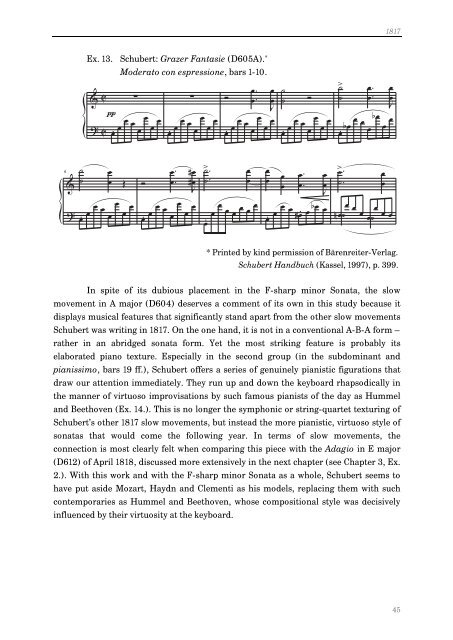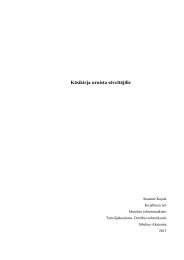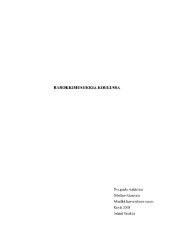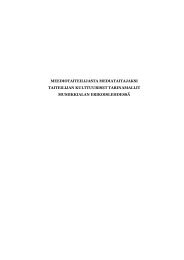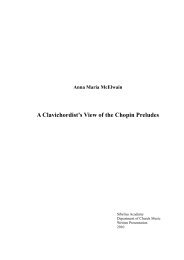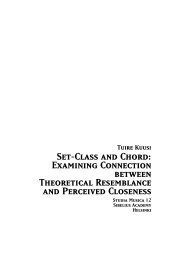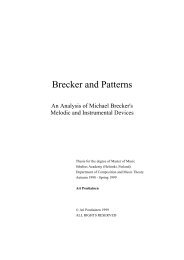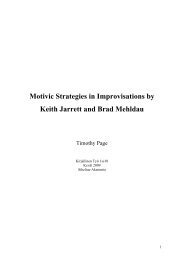The Unfinished Piano Sonatas of Franz Schubert Javier ... - Ethesis
The Unfinished Piano Sonatas of Franz Schubert Javier ... - Ethesis
The Unfinished Piano Sonatas of Franz Schubert Javier ... - Ethesis
You also want an ePaper? Increase the reach of your titles
YUMPU automatically turns print PDFs into web optimized ePapers that Google loves.
6<br />
&<br />
?<br />
˙ ˙<br />
Ex. 13. <strong>Schubert</strong>: Grazer Fantasie (D605A). *<br />
& C<br />
∑<br />
? C œ. œ œ π<br />
œ<br />
œ œ<br />
œ œ<br />
œ<br />
œ Œ<br />
œ. œ œ œ<br />
œ œ<br />
œ œ<br />
Moderato con espressione, bars 1-10.<br />
∑<br />
œ. œ œ œ<br />
œ œ<br />
œ œ<br />
Ó<br />
œ .<br />
œ .<br />
# œ<br />
# œ<br />
J<br />
œ. œ œ œ<br />
œ œ<br />
œ œ<br />
œ . œ<br />
Ó<br />
œ . œ<br />
J<br />
œ. œ œ œ<br />
œ œ<br />
œ œ<br />
> ˙ .<br />
œ<br />
˙ .<br />
œ<br />
œ . œ œ œ œ œ œ œ<br />
˙<br />
˙<br />
Ó<br />
œ. œ œ œ<br />
œ œ<br />
œ œ<br />
œ<br />
œ œ<br />
œ<br />
œ .<br />
œ .<br />
œ<br />
œ<br />
J<br />
œ. œ œ œ<br />
# œ.<br />
œ œ b œ<br />
> ˙<br />
œ .<br />
˙<br />
œ .<br />
œ. œ b<br />
> ˙ .<br />
˙ .<br />
1817<br />
œ<br />
œ<br />
J<br />
œ b œ<br />
œ<br />
œ œ œ<br />
œ<br />
œ<br />
œ œ<br />
n œ œ<br />
œ<br />
˙ œ˙ œ œ<br />
* Printed by kind permission <strong>of</strong> Bärenreiter-Verlag.<br />
<strong>Schubert</strong> Handbuch (Kassel, 1997), p. 399.<br />
In spite <strong>of</strong> its dubious placement in the F-sharp minor Sonata, the slow<br />
movement in A major (D604) deserves a comment <strong>of</strong> its own in this study because it<br />
displays musical features that significantly stand apart from the other slow movements<br />
<strong>Schubert</strong> was writing in 1817. On the one hand, it is not in a conventional A-B-A form –<br />
rather in an abridged sonata form. Yet the most striking feature is probably its<br />
elaborated piano texture. Especially in the second group (in the subdominant and<br />
pianissimo, bars 19 ff.), <strong>Schubert</strong> <strong>of</strong>fers a series <strong>of</strong> genuinely pianistic figurations that<br />
draw our attention immediately. <strong>The</strong>y run up and down the keyboard rhapsodically in<br />
the manner <strong>of</strong> virtuoso improvisations by such famous pianists <strong>of</strong> the day as Hummel<br />
and Beethoven (Ex. 14.). This is no longer the symphonic or string-quartet texturing <strong>of</strong><br />
<strong>Schubert</strong>’s other 1817 slow movements, but instead the more pianistic, virtuoso style <strong>of</strong><br />
sonatas that would come the following year. In terms <strong>of</strong> slow movements, the<br />
connection is most clearly felt when comparing this piece with the Adagio in E major<br />
(D612) <strong>of</strong> April 1818, discussed more extensively in the next chapter (see Chapter 3, Ex.<br />
2.). With this work and with the F-sharp minor Sonata as a whole, <strong>Schubert</strong> seems to<br />
have put aside Mozart, Haydn and Clementi as his models, replacing them with such<br />
contemporaries as Hummel and Beethoven, whose compositional style was decisively<br />
influenced by their virtuosity at the keyboard.<br />
45


